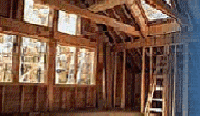Houston - Galveston - Texas Coastal Home Inspections I Coastal Inspector I Infrared Thermography I IRC Code Certified |
||
 |
|||||
 |
 |
||||
.. |
|||||
 |
|||||
The Repair Bills Arrive from the Housing Boom
Companies:
• D.R. Horton, Inc. Common Stock
• Lennar Corporation Class A Comm
• PulteGroup, Inc. Common Stock
Seattle city planner Alan Justad is reviewing a project that will bring back the cranes, dust, and noise absent since the real estate bust. Yet this one will subtract from the local skyline rather than add to it. The owners of McGuire Apartments opted to tear down the 10-year-old glass-clad building in the upscale Belltown neighborhood after discovering that steel support cables encased in its concrete structure had corroded. The repair bill would have been $60 million -- almost double the project's construction cost. "We've never had anything like this happen before," says Justad, who expects demolition of the 25-story tower to begin later this year.
The U.S. construction boom between 2000 and 2005 added more than 10 million apartments, condominiums, and single-family homes to the nation's housing stock. Although that building frenzy is long gone, it's still generating a repair bill for construction flaws that may hamper the industry's recovery. Homes with cracked foundations and sagging ceilings will only add to the supply of hard-to-sell properties, says Jack McCabe, chief executive officer of McCabe Research & Consulting, which tracks real estate. "A lot of construction flaws slipped through the cracks," he said. "We're just on the cusp of it now."
The rush to meet demand fueled by low interest rates and liberal lending resulted in a doubling of defects per newly constructed housing unit from 2000 through 2005, compared with the previous six-year period, according to International Association of Certified Home Inspectors estimates. Add to that the billions of dollars in repair costs and damages at stake in ongoing litigation over allegedly dangerous Chinese drywall imports, and builders are facing a skyscraper-sized liability headache. "Homebuilders don't want to draw attention to it, but they've got creeping costs for construction defects," says Vicki Bryan, an analyst at Gimme Credit in New York.
PulteGroup (NYSE:PHM - News), the largest U.S. homebuilder, recorded a one-time expense of $272.2 million in the third quarter, or 25 percent of its revenue for the period, to increase reserves to cover losses when homeowners demand repairs to houses built in the past 10 years. Chief Financial Officer Roger A. Cregg told analysts on Nov. 3 there was a "greater frequency of newly reported claims" by people with company-provided warranties. Pulte spokesman Jim Zeumer says, "We were building significantly more houses during that period, so part of this may just be the math of more homes."
Claims can take time to surface because home warranties typically span a decade -- which is also the amount of time many states allow for filing lawsuits for alleged defects.
That could mean some builders will need to set aside more money for repairs and legal claims in years to come, says Ron Kozlowski, a Hong Kong-based senior actuary at Towers Watson, a consultant to insurers. "Their liabilities are underfunded," he says, declining to identify specific builders. "They have their heads in the sand."
Replacing faulty Chinese drywall in U.S. homes may cost more than $15 billion alone, Kozlowski estimates. He said he has reviewed claims for other construction failings totaling $15 billion to $20 billion, including the kind of water intrusion that doomed the Seattle apartment building. "The whole construction defect issue is multiples" of the drywall amount, Kozlowski says.
D.R. Horton (NYSE:DHI - News), the second-largest homebuilder, puts its net liabilities for construction defects and other claims at $319.8 million on Sept. 30, more than double the $137.2 million on Sept. 30, 2003. The increase was due to the number of homes built, not any decline in quality, says D.R. Horton spokeswoman Jessica Hansen.
Homebuilders and subcontractors are finding it more difficult than five years ago to tap insurance to cover payments to homeowners because insurers have added so many exceptions, says Dave Stern, vice-president at West Coast Casualty Service, an insurance adjuster in Westlake Village, Calif. In California, "basically, the thing leaks, it's the builder that's liable," Stern says.
At Pulte, most of the claims in the third quarter were related to water intrusion, CEO Richard J. Dugas Jr. told analysts on Nov. 3. "That was completely unforeseen," he said. Given the 10-year warranty periods, it's a "tough science to nail down" when people will decide to ask for defects to be fixed, he said.
One reason for snowballing warranty claims: In the rush to make deals, buyers often didn't ask for inspections, which some mortgage companies didn't require, says Bruce Barker, an inspector in Phoenix for more than a decade. Natalie Crump didn't have her house inspected before moving into Hutto Parke, built in an old cotton field a 30-minute drive from Austin, Tex. She bought a three-bedroom home there with her husband Mike for $136,490 in 2006. Since then, the Crumps and owners of 12 other houses have filed lawsuits against builder Lennar (NYSE:LEN - News), claiming foundations are fracturing and fences sagging because the homes went up on unstable soil, according to their lawyer, Kyle Pugh of Dallas.
A year after they moved in, the Crumps spotted bubbles in the ceiling of their daughter's room that turned out to be nails sliding out of sheetrock, she says. Lennar officials told them it was because workers hammered the nails incorrectly, she says. Then the driveway sprouted a crack more than six feet long, she says, while ceilings inside bowed. Lennar offered to make repairs, she says. She and her husband sued instead. "Who wants a brand-new repaired house?" says Crump, a horse trainer.
A Lennar spokesman, Marshall Ames, said the "nail pops" the Crumps saw are common in homebuilding. The company offered to make sheetrock repairs to the 443 houses in the subdivision and 221 homeowners accepted, he said in an e-mail, adding that accusations in the lawsuits are unfounded. "Our homes have been built to the same consistent quality standards for years," and the construction boom didn't change that, he said.
The bottom line: Poor construction work during the housing boom has left U.S. builders facing billions of dollars in possible liabilities and damages.
The Repair Bills Arrive: Could Your Home Be One of Them?

